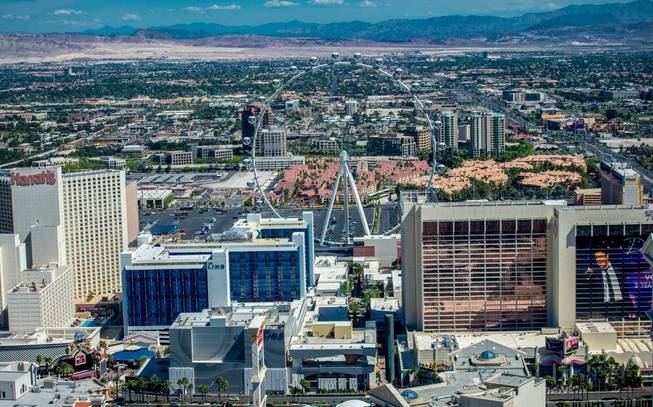
Tom Donoghue / DonoghuePhotography.com
Aerial views of the Las Vegas Strip on Friday, March 27, 2015, including the Rock in Rio USA site, MGM Arena behind New York-New York and Monte Carlo and Pawn Mall.
Wednesday, May 27, 2015 | 4:06 p.m.
Long the domain of cars and taxis, getting around the Las Vegas Strip could be a very different experience in 20 years — one that includes an underground light rail system, according to a draft transportation plan released today by a coalition of business and government groups.
Today's report gives a first glimpse of some of the proposed ideas to relieve congestion and modernize Las Vegas's transportation system. The recommendations range from massive long-term projects — like the proposed light rail running underground beneath the Strip — to smaller, more easily achievable suggestions like adding more pedestrian bridges over Las Vegas Boulevard and increasing staging areas for taxis at the airport and casinos.
Known formally as the Transportation Investment Business Plan, the draft report released today is still missing a key component: how to pay for the billions of dollars worth of proposed improvements.
That's something the group of stakeholders working on the plan, which includes the Regional Transportation Commission, casinos, taxi and limousine companies, the Las Vegas Convention and Visitors Authority, and local governments, are still figuring out. They plan to present possible funding mechanisms to the public later this year.
The planning process was launched more than a year ago with the goal of finding ways to build and pay for projects that will boost mobility along the Las Vegas Strip and the surrounding urban core including McCarran International Airport, downtown, UNLV and the medical district.
The process is being guided by North Carolina-based Michael Gallis & Associates under a $2.3 million contract.
The recommendations in the draft plan are organized into near, medium and long-term improvements based on how long they'll take to fund and complete. Here's a look at specific suggestions for each category:
Short-term improvements
The short-term improvements involve a variety of policy, technology and smaller-scale construction projects that could be completed in one to five years.
The suggestions focus on several areas, like improving the pedestrian experience by building more bridges over Las Vegas Boulevard and widening Strip sidewalks.
For vehicular traffic, the plan recommends improving connections between streets surrounding the Strip, reconfiguring roadways and widening Koval Lane.
The biggest recommended change is extending the Monorail to the Mandalay Bay Convention Center and adding a stop at the Sands Expo Convention Center.
Smaller items include adding real-time transit information to bus stops and creating a real-time parking mobile app.
Medium-term improvements
Improvements possible in the next five to 10 years begin to dream a bit bigger for the valley's transportation system, with talk of high-speed rail to Southern California and a new multimodal transportation hub at McCarran Airport.
This section also calls for a bus rapid transit or streetcar line down Maryland Parkway connecting the airport, UNLV and downtown Las Vegas.
Also included are new highway exits on I-15, increased connectivity for high-occupancy vehicle lanes and and a new interchange at I-515 and Maryland Parkway.
Long-term improvements
The long-term improvements provide the greatest potential for remaking the valley's transit system, but are also the most expensive and technically difficult.
The headliner is a light rail service that would run underneath Las Vegas Boulevard from Hacienda Avenue to Sahara Avenue, while also connecting to downtown Las Vegas and the airport.
The other major change recommended in this section is to extending and connecting east and west Russell Road underneath the airport.

Join the Discussion:
Check this out for a full explanation of our conversion to the LiveFyre commenting system and instructions on how to sign up for an account.
Full comments policy